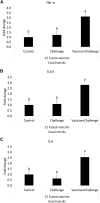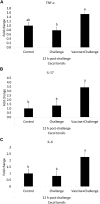Immunization of Broiler Chickens With a Killed Chitosan Nanoparticle Salmonella Vaccine Decreases Salmonella Enterica Serovar Enteritidis Load
- PMID: 35923229
- PMCID: PMC9340066
- DOI: 10.3389/fphys.2022.920777
Immunization of Broiler Chickens With a Killed Chitosan Nanoparticle Salmonella Vaccine Decreases Salmonella Enterica Serovar Enteritidis Load
Abstract
There is a critical need for an oral-killed Salmonella vaccine for broilers. Chitosan nanoparticle (CNP) vaccines can be used to deliver Salmonella antigens orally. We investigated the efficacy of a killed Salmonella CNP vaccine on broilers. CNP vaccine was synthesized using Salmonella enterica serovar Enteritidis (S. Enteritidis) outer membrane and flagella proteins. CNP was stable at acidic conditions by releasing 14% of proteins at pH 5.5. At 17 h post-incubation, the cumulative protein release for CNP was 75% at pH 7.4. Two hundred microliters of PBS with chicken red blood cells incubated with 20 μg/ml CNP released 0% hemoglobin. Three hundred chicks were allocated into 1) Control, 2) Challenge, 3) Vaccine + Challenge. At d1 of age, chicks were spray-vaccinated with PBS or 40 mg CNP. At d7 of age, chicks were orally-vaccinated with PBS or 20 μg CNP/bird. At d14 of age, birds were orally-challenged with PBS or 1 × 107 CFU/bird of S. Enteritidis. The CNP-vaccinated birds had higher antigen-specific IgY/IgA and lymphocyte-proliferation against flagellin (p < 0.05). At 14 days post-infection, CNP-vaccinated birds reversed the loss in gut permeability by 13% (p < 0.05). At 21 days post-infection, the CNP-vaccinated birds decreased S. Enteritidis in the ceca and spleen by 2 Log10 CFU/g, and in the small intestine by 0.6 Log10 CFU/g (p < 0.05). We conclude that the CNP vaccine is a viable alternative to conventional Salmonella poultry vaccines.
Keywords: Enteritidis; Salmonella; broilers; nanoparticles; vaccines.
Copyright © 2022 Acevedo-Villanueva, Akerele, Al-Hakeem, Adams, Gourapura and Selvaraj.
Conflict of interest statement
The authors declare that the research was conducted in the absence of any commercial or financial relationships that could be construed as a potential conflict of interest. The handling editor SV declared a shared parent affiliation with the author RG at the time of review.
Figures





Similar articles
-
Salmonella chitosan nanoparticle vaccine administration is protective against Salmonella Enteritidis in broiler birds.PLoS One. 2021 Nov 16;16(11):e0259334. doi: 10.1371/journal.pone.0259334. eCollection 2021. PLoS One. 2021. PMID: 34784366 Free PMC article.
-
Efficacy of a nanoparticle vaccine administered in-ovo against Salmonella in broilers.PLoS One. 2021 Apr 6;16(4):e0247938. doi: 10.1371/journal.pone.0247938. eCollection 2021. PLoS One. 2021. PMID: 33822791 Free PMC article.
-
Efficacy of chitosan-based nanoparticle vaccine administered to broiler birds challenged with Salmonella.PLoS One. 2020 Apr 24;15(4):e0231998. doi: 10.1371/journal.pone.0231998. eCollection 2020. PLoS One. 2020. PMID: 32330169 Free PMC article.
-
Temporal dynamics of innate and adaptive immune responses in broiler birds to oral delivered chitosan nanoparticle-based Salmonella subunit antigens.Vet Immunol Immunopathol. 2020 Oct;228:110111. doi: 10.1016/j.vetimm.2020.110111. Epub 2020 Aug 17. Vet Immunol Immunopathol. 2020. PMID: 32846353
-
Immune Response to Salmonella Enteritidis Infection in Broilers Immunized Orally With Chitosan-Based Salmonella Subunit Nanoparticle Vaccine.Front Immunol. 2020 May 19;11:935. doi: 10.3389/fimmu.2020.00935. eCollection 2020. Front Immunol. 2020. PMID: 32508828 Free PMC article.
Cited by
-
Nigella sativa-chitosan nanoparticles: Novel intestinal mucosal immunomodulator controls and protects against Salmonella enterica serovar Enteritidis infection in broilers.BMC Vet Res. 2023 Aug 1;19(1):103. doi: 10.1186/s12917-023-03632-1. BMC Vet Res. 2023. PMID: 37528439 Free PMC article.
-
Salmonella Infection in Poultry: A Review on the Pathogen and Control Strategies.Microorganisms. 2023 Nov 20;11(11):2814. doi: 10.3390/microorganisms11112814. Microorganisms. 2023. PMID: 38004824 Free PMC article. Review.
-
Recent Advances in Oral Vaccines for Animals.Vet Sci. 2024 Aug 5;11(8):353. doi: 10.3390/vetsci11080353. Vet Sci. 2024. PMID: 39195807 Free PMC article. Review.
-
Chitosan: a promising natural polysaccharide feed additive in poultry production systems.Iran J Vet Res. 2023;24(4):301-312. doi: 10.22099/IJVR.2023.46967.6751. Iran J Vet Res. 2023. PMID: 38799294 Free PMC article. Review.
-
Vaccine protection of broilers against various doses of wild-type Salmonella Typhimurium and changes in gut microbiota.Vet Q. 2025 Dec;45(1):1-14. doi: 10.1080/01652176.2024.2440428. Epub 2024 Dec 25. Vet Q. 2025. PMID: 39721950 Free PMC article.
References
-
- Abbas Abul K., Lichtman A. H., Pillai S. (2014). Cellular and Molecular Immunology. Amsterdam: Elsevier.
-
- Acevedo-Villanueva K. Y., Renu S., Shanmugasundaram R., Akerele G. O., Gourapura R. J., Selvaraj R. K. (2021c). Salmonella Chitosan Nanoparticle Vaccine Administration Is Protective against Salmonella Enteritidis in Broiler Birds. Plos One 16 (11), e0259334. 10.1371/journal.pone.0259334 - DOI - PMC - PubMed
LinkOut - more resources
Full Text Sources
Miscellaneous

